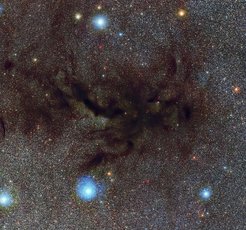Molecular outflow launched beyond the disk around a young star

Optical image of the dense core Barnard 59 obtained with the MPG/ESO 2.2m telescope. The young stellar object BHB07-11 cannot be seen in the image as it is hidden inside the dense gas and dust cloud for optical light. Radio waves, however, can pass through the material.
A long-standing problem of star formation is how to get rid of the excess of angular momentum from in-falling material in the molecular cloud where a young star is born. In the classical picture, angular momentum is removed both by a stellar wind close to the newly formed star and by a disk wind from a wide region in the protoplanetary disk around the star. The exact location from where such disk winds are launched, however, is not well known.
Low-mass Young Stellar Objects (YSO), the precursors of Solar-type stars, have a prominent circumstellar disk surrounded by a tenuous envelope. The structure and kinematics of the environment of such young stars can be studied at radio wavelengths, where the dust in disk and envelope emits thermal radiation and where rotational transitions of some simple molecules (such as CO) can be used as tracers of gas motions. An international team of astronomers, led by the Max Planck Institute for Extraterrestrial Physics (MPE), now used the ALMA radio telescope to investigate the young stellar object BHB07-11, which is embedded in the Barnard 59 dense core in the Pipe nebula.

This radio image obtained with ALMA shows the intensity of the dust continuum emission of BHB07-11. The contrast between the disk and the envelope including spirals is clearly visible.
“Our continuum data reveal an unprecedented view of the dust distribution in the YSO,” points out Felipe O. Alves from MPE, the lead author of the paper describing the study. “We achieved an enhanced brightness contrast between the circumstellar disk and the surrounding tenuous material - even showing spiral structures.”
Even more impressive, however, are the observations of the molecular tracers: They show a bipolar outflow launched at symmetric positions with respect to the disk at quite a large distance from the centre. This is the first time that outflow material is seen ejected not from the disk but beyond its edge.
The large offset of the launching position coincides with the landing site of the infall material from the surrounding parent cloud, which could be identified using formaldehyde (H2CO) molecular lines. “Molecules are precious tools to selectively trace various parts of the complex regions where Solar-type stars are born and unveil important physical processes,” says Paola Caselli, a co-author of the paper.

Here, observations of the CO molecular lines are shown on top of the dust emission. The emission by the molecules is slightly shifted to longer or shorter wavelengths depending on the velocity of the material relative to the observer. Therefore the panel on the left shows material moving towards us (blue lobe), while the panel right shows motion away from us (red lobe). The launch sites are at the edge of the disk and both outflows are asymmetric.
At the landing site, models predict that magnetic field lines are strongly pinched due to the dragging of the in-falling gas from the inner envelope. The resulting enhanced magnetic field leads to outflows that are efficiently ejected by a magneto-centrifugal mechanism within a narrow region outside the disk edge.
The close connection between the in- and outflowing gas is also supported by the asymmetry observed in both observations. “The high resolution data allows us to identify a sharp transition in the gas kinematics across the spiral structure, which pinpoints the location of the so-called centrifugal barrier where the gas lands in the disk and only rotational motion is left,” says Alves. These landing sites of the infall streams onto the disk are asymmetric; hence, also the bipolar outflows should be asymmetric – unlike in the classical disk wind picture.














